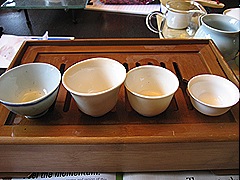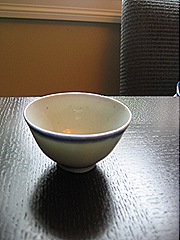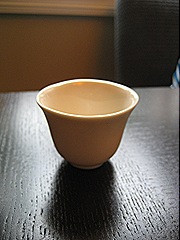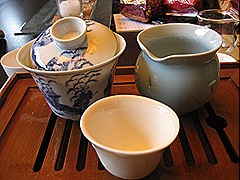After a week of using my new, wood-fired gaiwan, I have gotten used to the particulars that it requires to brew better tea. Water temperature that is a tad lower than I usually use, a slightly longer brewing time, and unlike my basic gaiwan, this one prefers to have the lid kept closed between brewings. The result is tea that tastes more "alive;" the fragrance alone lingers on the lid for over 15 minutes, which is about 13 minutes longer than with my other gaiwan.
Having definitively decided that this is the better brewing vessel, I had to choose a suitable cup to match.
The candidates above, from L to R, are: Qing-dynasty wood-fired cup; modern hand-made Dehua oval cup (Blanc de Chine porcelain); modern hand-made Dehua round cup, and a regular, nothing-special porcelain tasting cup. The test brew: Winter 2008 Dong Ding.
After the rinse and the first two pours, it was evident that the normal tasting cup - the standard - showed unremarkable improvements to the taste of the tea. It felt like the cup was preventing the subtle flavors and aromas of the tea from showing up. The round Dehua cup (my daily drinking cup) had fragrance that lingered within it for several minutes. Improvement to the taste of the tea was marginal in comparison to the oval Dehua cup and the Qing cup, so it, along with the standard, were removed from the competition.
The semi-finals: Aged vs Modern beauty. Pour after pour, the Qing cup gave the tea bold and strong flavors. It highlighted the tea's thick, fruity taste without making it overbearing. This cup captured the essence of the Dong Ding and clearly demonstrates it to its user.
The oval Dehua cup I know very well. It makes tea soft and gentle. It gives balance to my brews, providing a smooth surface that each drop wants to cling to, as if reluctant to depart from it. It makes the Dong Ding taste silky and refined, taking the edge off of the slightly-astringent bite of bitterness that comes from the brewed stems. I spent 3 hours at Wistaria trying cups, as Zhou Yu and his wife sat by me working (with an occasional grin as they found my experiments to be borderline obsessive). Because of its ability to balance tea, I only use it on good teas that I've already bought - it gives too many benefits to teas during a tasting.
Drinking a sip from each cup, one after the other, is revealing. Qing first followed by oval Dehua results in a smooth liquid with a slightly off taste, as if the liquid is not reaching the correct tastebuds. The other way around results in astringent tea that is slightly bitter - too much flavor.
I brewed two other teas - a Winter 07 Dong Ding and a 94 Tieguanyin. For the moderate-roast but high-fire Tieguanyin, the Qing cup made the flavors pop out. Overwhelmingly fruity and deep, with the richness of charcoal fire. However, it was too much flavor for my enjoyment; the Hui Gan did not appear until several infusions later. The Dehua cup made the Tieguanyin soft. Purists might not like it this way, as TGY is a favorite for the espresso-like brews of the Chaozhou Gongfu method, aimed at bringing out the deep richness of the tea. But I want to taste the spectrum of the tea's flavors and scents.
I prefer smoothness, but can see instances where the Qing cup could better highlight the tastes of teas that I don't know well. I think it would do particularly well with Wuyi cliff teas.
The winning combo for me - wood-fired gaiwan, Celadon Dehua pouring pitcher and Oval Dehua cup. Balanced flavors that reveal different taste sensations from the beginning of your first slurp, to the time you swallow, and then when the aftertastes return in the Hui Gan and Hui Wei. With a bit of good tea residue, the pitcher will retain its fragrance overnight.
My Dehua teaware is from Wistaria (Zi Teng Lu) in Taipei. Unfortunately, they don't currently ship orders like this overseas, so you've gotta find a friend to help. These Dehua cups are about $15-$25 each. The celadon pitcher, if I recall correctly, is about $50. The Gaiwan is from Arts de Chine in Vancouver, BC and was about $56 CDN. The Qing cup was about $27 CDN.












i know in wine the different sized glasses (size of the mouth) brings out different flavors as the shape of the glass concentrates the wine in specific areas of your palette... i wonder if in tea it is the same; the difference in the cups size and shape as opposed to the material. Would a Qing cup and a Dehua cup of the same size and shape provide different tasting experiences?
ReplyDeleteIt's true, different shapes affect the taste and smell a lot. I have Dehua cups in 4 different shapes and all make different impressions upon the tea. However, different types of material/porcelain make an even bigger difference. The tea experts explain that it's because of the characteristics of each type of clay used in different porcelains, as well as the methods of production (e.g. wood/gas/electric kiln fired), etc that affect the product. If you feel the Qing and Dehua cups, there is a distinctly different texture and thickness between the two.
ReplyDelete